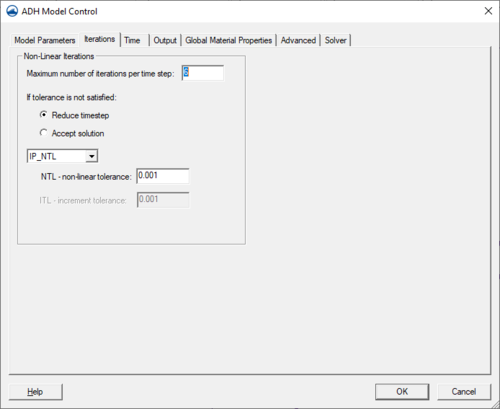SMS:ADH Model Control Iterations
| This contains information about features no longer in use for the current release of SMS. The content may not apply to current versions. |
Iteration parameters are set in the ADH Model Control dialog (ADH | Model Control... command). It is accessed in the ADH Model Control dialog by clicking on the Iterations tab.
Iterations
The Iterations tab allows specifying the level of precision for the conservation of mass and momentum as ADH performs its calculations.
ADH solves conservation statements concerning water volume, momentum, and constituent mass. ADH is written in conservative form and thus can be regarded as both a finite element method and also a finite volume method. As such ADH can be shown to represent a sum of fluxes around the edge of an element to be in balance with the mass or volume change within the element. In the case of the momentum equation it will be a sum of fluxes and forces balancing the momentum change within an element.
ADH computes the water levels and velocities at each computation point in the domain for each time step in the simulation in an iterative process. At the end of each iteration, calculations are made to determine how much the solution is changing and what the errors in conservation are. If the errors are small, and the solution is not changing, the process is said to be converged and calculations can proceed to the next time step. If the solution is changing and/or the errors in conservation are large, ADH can attempt another iteration.
There are several iteration parameter controls in ADH. These are described in detail in the ADH users manual. The Solver options tab controls the linear iterations. This dialog controls the non-linear iteration parameters.
At the end of each iteration ADH computes the conservation properties for the current approximations of water depth and velocity. If the errors are less than specified tolerance, the solver moves on to the next time step. If the errors are greater than the specified tolerance, but still reasonable, and the maximum number of iterations specified on the IP NIT card has not been reached, ADH will attempt another iteration. If the errors have become unreasonable (divergence), ADH will exit the loop with a failure notification. The controls in this dialog allow defining how ADH should determine convergence and how to proceed when convergence is not reached.
Maximum Number of Iterations Per Time Step (IP NIT and IP FNI Cards)
In this edit field specify the maximum number of iterations that ADH will try for a single time step. By examining the output for successive iterations, determine if the process is converging in general (trending towards zero), or oscillating. If the trend is towards convergence, this maximum number of iterations can be increased. As the value increases, ADH can spend more time processing individual time steps which may decrease the overall efficiency of the solver. For this reason, do not simply increase this parameter without verifying that it will be beneficial.
SMS writes either the IP NIT or IP FNI card based on the setting of the If tolerance is not satisfied radio group.
- IP NIT card is written if the Reduce time step option is selected. (Recommended)
- IP FNI card is written if the Accept solution option is selected.
The IP FNI card instructs ADH to continue with the solution as if it had converged. This is not recommended.
When the Reduce time step option is selected and the solution has diverged or the maximum number of iterations have been attempted, ADH will reduce the time step size to ¼ of the previous and continue the calculations.
When the Accept solution option is selected, and the maximum number of iterations have been attempted, ADH proceeds as if convergence has been reached to the next time step. (This option is not recommended.)
NTL/ITL/Both Combo Box
- NTL (IP_NTL Card)
- If the "NTL" option is selected, ADH will check for non-linear convergence on the "maximum residual norm". An initial estimate for an appropriate tolerance value for a problem can be computed as:
- Failed to parse (SVG with PNG fallback (MathML can be enabled via browser plugin): Invalid response ("Math extension cannot connect to Restbase.") from server "https://en.wikipedia.org/api/rest_v1/":): {\displaystyle \cfrac{(total\_area \ast 10^{-6})}{\#\_elements}}
- This is the maximum allowance. It will likely be desirable to set the tolerance higher than this estimate so the simulation will progress.
- ITL (IP_ITL Card)
- If the ITL option is selected, ADH will check for non-linear convergence on the "maximum increment norm" or the change in the solution (velocity, depth and concentration).
- Both
- If the Both option is selected, SMS will write both cards to the BC file and ADH will check for convergence on both terms. Both must be satisfied for the solution to proceed.
Related Topics
SMS – Surface-water Modeling System | ||
|---|---|---|
| Modules: | 1D Grid • Cartesian Grid • Curvilinear Grid • GIS • Map • Mesh • Particle • Quadtree • Raster • Scatter • UGrid |  |
| General Models: | 3D Structure • FVCOM • Generic • PTM | |
| Coastal Models: | ADCIRC • BOUSS-2D • CGWAVE • CMS-Flow • CMS-Wave • GenCade • STWAVE • WAM | |
| Riverine/Estuarine Models: | AdH • HEC-RAS • HYDRO AS-2D • RMA2 • RMA4 • SRH-2D • TUFLOW • TUFLOW FV | |
| Aquaveo • SMS Tutorials • SMS Workflows | ||
